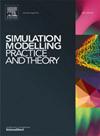Comparing Control Theory and Deep Reinforcement Learning techniques for decentralized task offloading in the edge–cloud continuum
IF 3.5
2区 计算机科学
Q2 COMPUTER SCIENCE, INTERDISCIPLINARY APPLICATIONS
引用次数: 0
Abstract
With the increasingly demanding requirements of Internet-of-Things (IoT) applications in terms of latency, energy efficiency, and computational resources, among others, task offloading has become crucial to optimize performance across edge and cloud infrastructures. Thus, optimizing the offloading to reduce latency as well as energy consumption and, ultimately, to guarantee appropriate service levels and enhance performance has become an important area of research. There are many approaches to guide the offloading of tasks in a distributed environment, and, in this work, we present a comprehensive comparison of three of them: A Control Theory (CT) Lyapunov optimization method, 3 Deep Reinforcement Learning (DRL) based strategies and traditional solutions, like Round-Robin or static schedulers. This comparison has been conducted using ITSASO, an in-house developed simulation platform for evaluating decentralized task offloading strategies in a three-layer computing hierarchy comprising IoT, fog, and cloud nodes. The platform models service generation in the IoT layer using a configurable distribution, enabling each IoT node to decide whether to autonomously execute tasks (locally), offload them to the fog layer, or send them to the cloud server. Our approach aims to minimize the energy consumption of devices while meeting tasks’ latency requirements. Our simulation results reveal that Lyapunov optimization excels in static environments, while DRL approaches prove to be more effective in dynamic settings, by better adapting to changing requirements and workloads. This study offers an analysis of the trade-offs between these solutions, highlighting the scenarios in which each scheduling approach is most suitable, thereby contributing valuable theoretical insights into the effectiveness of various offloading strategies in different environments. The source code of ITSASO is publicly available.

边缘云连续体中分散任务卸载的控制理论与深度强化学习技术比较
随着物联网(IoT)应用程序在延迟、能效和计算资源等方面的要求越来越高,任务卸载对于优化跨边缘和云基础设施的性能变得至关重要。因此,优化卸载以减少延迟和能耗,并最终保证适当的服务水平和提高性能已成为一个重要的研究领域。有许多方法可以指导分布式环境中的任务卸载,在这项工作中,我们对其中三种进行了全面的比较:一种控制理论(CT) Lyapunov优化方法,3种基于深度强化学习(DRL)的策略和传统的解决方案,如轮询或静态调度程序。这项比较是使用ITSASO进行的,ITSASO是一个内部开发的仿真平台,用于评估由物联网、雾和云节点组成的三层计算层次结构中的分散任务卸载策略。该平台使用可配置的分布对物联网层中的服务生成进行建模,使每个物联网节点能够决定是自主执行任务(本地),将它们卸载到雾层,还是将它们发送到云服务器。我们的方法旨在最大限度地减少设备的能耗,同时满足任务的延迟要求。我们的模拟结果显示,Lyapunov优化在静态环境中表现出色,而DRL方法在动态环境中更有效,可以更好地适应不断变化的需求和工作负载。本研究提供了这些解决方案之间的权衡分析,突出了每种调度方法最适合的场景,从而为不同环境下各种卸载策略的有效性提供了有价值的理论见解。ITSASO的源代码是公开的。
本文章由计算机程序翻译,如有差异,请以英文原文为准。
求助全文
约1分钟内获得全文
求助全文
来源期刊

Simulation Modelling Practice and Theory
工程技术-计算机:跨学科应用
CiteScore
9.80
自引率
4.80%
发文量
142
审稿时长
21 days
期刊介绍:
The journal Simulation Modelling Practice and Theory provides a forum for original, high-quality papers dealing with any aspect of systems simulation and modelling.
The journal aims at being a reference and a powerful tool to all those professionally active and/or interested in the methods and applications of simulation. Submitted papers will be peer reviewed and must significantly contribute to modelling and simulation in general or use modelling and simulation in application areas.
Paper submission is solicited on:
• theoretical aspects of modelling and simulation including formal modelling, model-checking, random number generators, sensitivity analysis, variance reduction techniques, experimental design, meta-modelling, methods and algorithms for validation and verification, selection and comparison procedures etc.;
• methodology and application of modelling and simulation in any area, including computer systems, networks, real-time and embedded systems, mobile and intelligent agents, manufacturing and transportation systems, management, engineering, biomedical engineering, economics, ecology and environment, education, transaction handling, etc.;
• simulation languages and environments including those, specific to distributed computing, grid computing, high performance computers or computer networks, etc.;
• distributed and real-time simulation, simulation interoperability;
• tools for high performance computing simulation, including dedicated architectures and parallel computing.
 求助内容:
求助内容: 应助结果提醒方式:
应助结果提醒方式:


